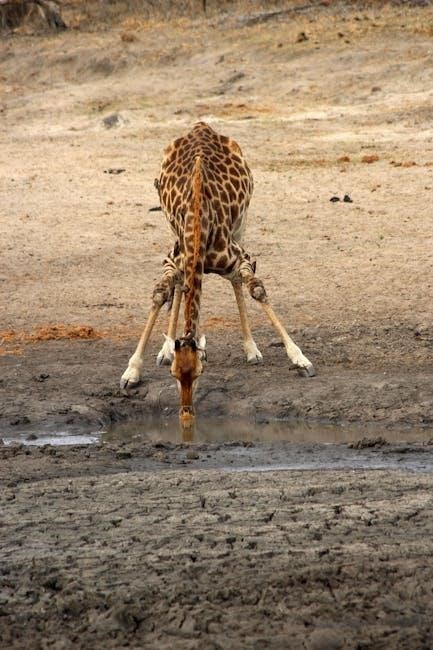Mastering wilderness long-term survival requires a blend of modern skills and traditional bushcraft. This guide equips you with essential techniques to thrive in nature, from building shelter to purifying water, ensuring self-reliance and confidence in the wild.
Understanding the Importance of Mental Resilience
Mental resilience is the cornerstone of long-term wilderness survival. Maintaining a positive mindset helps overcome fear, stress, and uncertainty. Experienced survivors emphasize the importance of staying focused and calm, as panic can cloud judgment and lead to poor decisions. Cultivating mental toughness ensures you remain adaptable and resourceful, even in harsh conditions. A strong mental foundation, combined with practical skills, is key to thriving in the wild and staying motivated to endure until rescue or self-reliant success.
Key Principles for Thriving in the Wild
Adaptability, self-reliance, and resourcefulness are key to thriving in the wild. Prioritize basic needs: shelter, water, and food, while staying aware of surroundings. Using available materials effectively and conserving energy ensures long-term sustainability. Balancing practical skills with mental resilience fosters confidence and the ability to overcome challenges. These principles guide you to transform the wilderness into a survivable, even comfortable, environment, ensuring you not only survive but truly live off the land with confidence and skill, as emphasized in expert survival guides.
Building Shelter for Long-Term Survival
Constructing durable shelters using natural materials like branches, leaves, and snow ensures protection from harsh weather. Techniques include lean-tos, debris huts, and dugouts, providing long-term refuge in the wild.
Natural Shelters and Improvisation Techniques
Natural shelters like caves, rock overhangs, and hollowed logs offer immediate protection. Improvise using tarps, branches, and snow to create durable structures. Utilize fallen trees or animal dens for temporary refuge. Always ensure shelters are safe, dry, and shielded from wind. Adapt materials to suit seasonal conditions, such as snow walls for winter or leaf-lined pits for warmth. Mastery of these techniques enhances survival chances, providing reliable shelter in diverse wilderness environments.
Constructing Shelters Using Available Materials
Constructing shelters with available materials is crucial for long-term survival. Use fallen branches, leaves, and pine needles to build lean-to structures or debris huts. Snow can be shaped into igloos or walls for insulation. Always prioritize water resistance and structural integrity. Secure frames with ropes or vines, and layer materials for durability. Practice these skills to create reliable shelters that protect against harsh weather, ensuring safety and comfort in the wilderness.

Water Purification and Management
Purifying water is vital for survival. Use methods like boiling, sand filtration, and solar disinfection to ensure safety. Manage water resources wisely to sustain long-term needs.
Methods for Finding and Purifying Water
Locating water sources is crucial for survival. Look for streams, ponds, or collect dew and rainwater. Purify water using methods like boiling, sand filtration, or solar disinfection. Boiling is the most reliable, killing all pathogens. Sand filtration removes sediment, while solar disinfection uses UV light to sanitize. Always prioritize water safety to avoid illness. These techniques ensure access to clean drinking water, essential for long-term wilderness survival.
Conserving Water for Extended Periods
Conserving water is vital for long-term survival. Limit daily intake to essential needs, avoiding unnecessary consumption. Ration water for cooking and hygiene, prioritizing drinking water. Collect rainwater using tarps or leaves, and utilize transpiration from plants. Efficiently use water for washing and cooking to minimize waste. These strategies ensure water availability, critical for sustaining life in the wilderness over extended periods.

Food Procurement and Preparation
Wilderness survival requires mastering food procurement through hunting, trapping, and foraging. Learn to identify edible plants and safely prepare wild foods for sustenance and energy.
Hunting, Trapping, and Foraging for Sustenance
Hunting, trapping, and foraging are critical skills for long-term wilderness survival. Learn to identify edible plants, set traps, and hunt effectively. Use bows, snares, and fishing gear to procure protein. Foraging requires knowledge of wild foods to avoid poisoning. Sustainable practices ensure a steady food supply. Always prioritize safety and efficiency to conserve energy. Mastering these techniques enables you to thrive in the wild, relying on nature for sustenance.
Preparing Wild Foods Safely and Effectively
Preparing wild foods requires skill to ensure safety and nutrition. Clean and cook meats thoroughly to avoid disease. Use fire for cooking, ensuring foods reach safe temperatures. Forage plants by identifying edible species accurately. Avoid contaminated or poisonous foods. Store leftovers properly to prevent spoilage. Use simple tools for processing, like knives and makeshift utensils. Efficient preparation minimizes waste and energy use, crucial for long-term survival. Always prioritize hygiene to maintain health in the wilderness.
First Aid and Health Maintenance
Essential skills include wound cleaning, fracture management, and herbal remedy use. Prioritize hygiene, nutrition, and mental resilience to prevent illnesses and maintain long-term well-being in the wild.
Essential First Aid Techniques for Wilderness Injuries
Mastering first aid is crucial for wilderness survival. Learn to clean and dress wounds, manage fractures, and treat burns. Use herbal remedies for infections and pain relief. Stay calm and prioritize hygiene to prevent complications. Know how to identify and respond to allergic reactions, snake bites, or hypothermia. Regularly monitor injuries for signs of infection, such as swelling or redness. Mental resilience plays a key role in recovery, so maintain a positive mindset and conserve energy for healing. Always carry a basic first aid kit tailored to long-term wilderness scenarios.
Maintaining Physical and Mental Health Long-Term
Mental and physical health are vital for long-term wilderness survival. Stay hydrated, eat nutritious food, and maintain a balanced diet with foraged resources. Exercise regularly to keep your body strong and agile. Mental resilience can be strengthened through meditation, journaling, and setting achievable goals. Dr. Nicole Apelian emphasizes the importance of adapting to nature, not conquering it. A structured daily routine helps maintain focus and well-being. Prioritize rest to avoid burnout and stay mentally sharp for challenges ahead.

Signaling for Help and Navigation
Signaling for help and navigation are critical for wilderness survival. Use mirrors, flares, or smoke to signal. Navigate with compasses, natural signs, or the Military Phonetic Alphabet for clarity.
Effective Methods for Signaling Rescue
Signaling for rescue is crucial in wilderness survival. Use reflective surfaces, flares, or smoke to catch attention. Create large, visible signals like “HELP” using logs or rocks. Utilize whistles, as their sound travels far. The Military Phonetic Alphabet can enhance radio communication clarity. Stay visible by wearing bright colors or tying ribbons to trees. Consistent signaling increases the chances of being spotted by rescuers. Combine multiple methods for maximum visibility and effectiveness in emergency situations.
Navigation Techniques Using Natural and Modern Tools
Navigation in the wilderness requires skill and resourcefulness. Use natural tools like the sun, stars, and landmarks to determine direction. Modern tools such as GPS devices, compasses, and maps enhance accuracy. The Military Phonetic Alphabet aids in clear communication of coordinates. Combine natural observations with modern technology for reliable navigation. Marking trails with natural markers prevents disorientation. Mastering these techniques ensures confidence in traversing unfamiliar terrain, whether relying on ancient methods or advanced gadgets, to stay on course and find your way safely.

Building a Sustainable Camp
Creating a sustainable camp involves selecting a durable site, optimizing resource use, and minimizing environmental impact. Choose flat ground near water sources for long-term living efficiency and safety.
Creating a Long-Term Campsite
Establishing a long-term campsite requires careful planning and resource management; Choose a location with access to water, shelter materials, and natural resources. Build a sturdy shelter using debris huts, lean-tos, or snow shelters, depending on the environment. Organize the site into functional zones for cooking, sleeping, and storage. Use local materials to minimize your footprint and ensure sustainability. Properly manage water sources and waste to maintain hygiene and avoid contamination. A well-designed campsite enhances safety and comfort, making long-term wilderness living feasible and efficient.
Managing Resources for Extended Wilderness Living
Effective resource management is crucial for extended wilderness living. Prioritize water conservation by collecting rainwater and minimizing usage. Ration food supplies and supplement with foraged or hunted resources. Manage firewood efficiently, using hardwoods for long-lasting coals. Maintain tools and gear to prevent wear and tear. Implement waste management strategies to preserve the environment. By carefully managing resources, you ensure sustainability and reduce reliance on external supplies, fostering self-reliance and extending your ability to thrive in the wild.
Mastering wilderness survival skills empowers you to thrive in nature. Build shelter, purify water, and hunt sustainably. Stay mentally resilient and prepared for any challenge, ensuring long-term success.
Wilderness survival hinges on adaptability and knowledge. Build shelters using natural materials, purify water with solar disinfection, and hunt with handmade tools. Signal for help using smoke or mirrors. Stay mentally resilient by setting daily goals and maintaining a positive outlook. Manage resources wisely to sustain long-term living. These strategies, combined with preparation and practice, ensure survival and the ability to thrive in the wild, transforming it into a second home.
Final Thoughts on Mastering Wilderness Survival
Mastery of wilderness survival lies in adaptability, mental resilience, and deep respect for nature. By understanding the land, managing resources wisely, and staying prepared, you can transform the wild into a second home. Confidence grows through practice, enabling you to face challenges with clarity and determination. Ultimately, wilderness survival is not just about enduring—it’s about thriving, fostering a profound connection with the natural world, and embracing self-reliance as a way of life.
